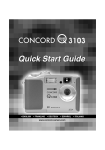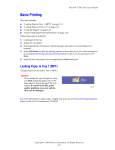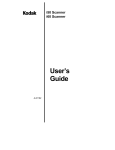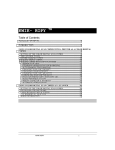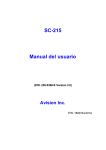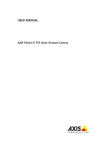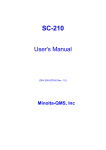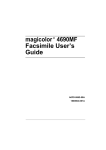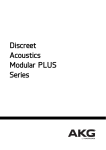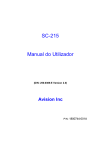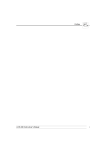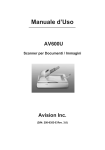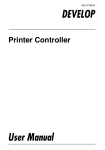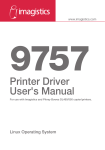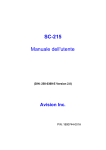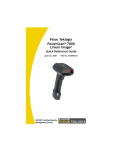Download SC-215 User`s Manual - Printers
Transcript
SC-215 User's Manual (D/N: 250-0369-E Version 2.0) P/N: 1800744-001A Trademarks Microsoft is a U.S. registered trademark of Microsoft Corporation. Windows and MS-DOS are trademarks of Microsoft Corporation. DOS is never used in the manual. IBM, PC, AT, XT are registered trademarks of International Business Machines Corp. AT and XT are never used in the manual. Other brands and product names herein are trademarks or registered trademarks of their respective holders. Copyright All rights reserved. No part of this publication may be reproduced, transmitted, transcribed, stored in a retrieval system, or translated into any language or computer language, in any form or by any means, electronic, mechanical, magnetic, optical, chemical, manual, or otherwise, without the prior written permission of the manufacturer. Material scanned by this product may be protected by governmental laws and other regulations, such as copyright laws, the customer is solely responsible for complying with all such laws and regulations. Warranty The information contained in this document is subject to change without notice. The manufacturer makes no warranty of any kind with regard to this material, including, but not limited to, the implied warranties of fitness for a particular purpose. The manufacturer shall not be liable for errors contained herein or for incidental or consequential damages in connection with the furnishing, performance, or use of this material. ii - FCC Radio Frequency Interference Statement This equipment has been tested and found to comply with the limits for a Class B digital device, pursuant to Part 15 of the FCC rules. These limits are designed to provide reasonable protection against harmful interference in a residential installation. This equipment generates, uses, and can radiate radio frequency energy and, if not installed and used in accordance with the instructions, may cause harmful interference to radio communication. However, there is no guarantee that interference will not occur in a particular installation. If this equipment does cause harmful interference to radio or television reception, which can be determined by turning the equipment off and on, the user is encouraged to try to correct the interference by one or more of the following measures: * Reorient or relocate the receiving antenna. * Increase the separation between the equipment and receiver. Connect the equipment into an outlet on a circuit different from that to which the receiver is connected. * Consult the dealer or an experienced radio/TV technician for help. FCC CAUTION: To assure continued compliance,(example- use only shielded interface cables when connecting to computer or peripheral devices). Any changes or modifications not expressly approved by the party responsible for compliance could void the user's authority to operate the equipment. This device complies with Part 15 of the FCC Rules. Operation is subject to the following two conditions: (1) This device may not cause harmful interference, and (2) this device must accept any interference received, including interference that may cause undesired operation. Responsible Party: Avision Labs, Inc. Telephone No.: +1 (510) 739-2369 iii Table of Contents 1. INTRODUCTION .........................................................1-1 2. SC-215 INSTALLATION ............................................2-1 2.1 2.2 2.3 2.4 3. USING THE SC-215 AS A COPIER.........................3-1 3.1 3.2 3.3 3.4 3.5 4. Precautions ......................................................... 2-1 Unlocking the SC-215 ......................................... 2-2 Connecting the Cable.......................................... 2-3 Document Placement ......................................... 2-5 Connectivity ......................................................... 3-2 The Control Panel .............................................. 3-4 Before making copies ......................................... 3-7 Making Simple Copies ......................................... 3-8 Making Copies with Copy Features .................... 3-9 USING THE SC-215 AS A SCANNER....................4-1 4.1 4.2 4.3 4.4 Installation Procedures ........................................ 4-2 Downloading a printer color table........................ 4-3 To Customize Color Tables on THE SC-215 ..... 4-5 Uninstall the SC-215 driver ................................. 4-7 5. SCANNER OPERATION AND DOCUMENT PRINTING.....................................................................5-1 6. USER INTERFACE ....................................................6-1 6.1 6.2 6.3 6.4 6.5 Scan method ....................................................... 6-1 Determining The resolution ................................. 6-2 Selecting The proper image type ........................ 6-4 Brightness ........................................................... 6-8 Contrast............................................................... 6-9 iv - 6.6 6.7 6.8 6.9 6.10 6.11 6.12 6.13 6.14 6.15 6.16 6.17 6.18 6.19 6.20 6.21 6.22 Invert Image ....................................................... 6-10 Mirror ................................................................. 6-11 Preview Auto-Area............................................. 6-11 Paper Size......................................................... 6-12 Units .................................................................. 6-12 Descreen........................................................... 6-13 Sharpen ............................................................. 6-13 Color Adjustment............................................... 6-14 Auto Level .......................................................... 6-14 Advanced Settings ............................................ 6-14 Miscellaneous .................................................... 6-22 Working with Quick Selector............................. 6-24 Your first scan with PaperCom ......................... 6-30 Working with the Bundled applications ............. 6-33 Your First Photo Scan with PhotoSuite............. 6-33 Your First OCR Scan with TextBridge .............. 6-35 Printing .............................................................. 6-37 7. MAINTENANCE ..........................................................7-1 8. SC-215 AUTOMATIC DOCUMENT FEEDER (ADF). ..................................................................................... 8-1 8.1 8.2 8.3 8.4 9. TROUBLE SHOOTING ..............................................9-1 9.1 9.2 10. Installing the ADF ................................................ 8-1 Using the ADF ..................................................... 8-7 Maintaining the ADF .......................................... 8-11 Clearing a Paper Jam ....................................... 8-16 Questions and Answers...................................... 9-1 Technical Support.............................................. 9-5 SPECIFICATIONS.................................................. 10-1 v 1. Introduction Congratulations on your purchase of an SC-215. The SC-215 produces better printing quality and is freer from maintenance than traditional copy machines. Its high copy/scan quality, maintenance-free operation, and affordability make SC215 the best convenience copier solution for the office. The following sections provide unpacking, hardware and software installation, operation, and maintenance information. Please spend a few minutes reading through them to ensure quality copying and scanning. Figure 1-1 shows how the SC-215 is packed. Please check all the items against Figure 1-1. If anything is missing or damaged, please contact your vendor immediately for replacement. 1-1 6 2 1 4 3 5 Utilities & Documentation CD Power Adapter/Cord Parallel Cable for Computer Connection Parallel Cable for Printer Connection USB Cable 6. SC-215 1. 2. 3. 4. 5. Figure 1-1 SC-215 Packing 1-2 - 2. SC-215 installation 2.1 PRECAUTIONS Ÿ Keep the SC-215 out of direct sunlight. Direct exposure to the sun or excessive heat may cause damage to the unit. Do not install the SC-215 in a humid or dusty place. Be sure to use the proper AC power source. Place the SC-215 securely on an even, flat surface. Tilted or uneven surfaces may cause mechanical or paper-feeding problems. Retain the SC-215 box and packing materials for shipping purposes. Ÿ Ÿ Ÿ Ÿ 2-1 2.2 UNLOCKING THE SC-215 To protect the scanning head from damage during shipment, the SC-215 is designed with a lock switch beneath the main unit. Therefore, before using the SC-215, it is required that you unlock the SC-215 by moving the lock switch to the Use position. (See Figure 2-1.) 1 2 1. “Shipping” Position 2. “Use” Position Figure 2-1 Unlocking the SC-215 2-2 - 2.3 CONNECTING THE CABLE 2.3.1 CONNECTING THE SC-215 TO A PRINTER TO USE AS A COPIER Connect the power cord and printer cable as shown below. Printer Cable Power Cord To Printer To Power Outlet Figure 2-2 Connecting the SC-215 to a printer Note: Only use the AC adapter (SA60-24 made by Sino America) included in the machine. Using other AC adapters may damage the machine and void the warranty. 2-3 2.3.2 CONNECTING THE SC-215 TO A WINDOWS WORKSTATION TO USE AS A SCANNER Connect the power cord and USB cable as shown below. USB Cable Power Cord To Power Outlet To PC USB Port Figure 2-3 SC-215 Cable Connection 2-4 - 2.4 DOCUMENT PLACEMENT As shown+ in Figure 2-4, place the document on the glass face (text) down. 2 1 3 4 1. 2. 3. 4. Document Cover Home Position Mark Document Document Glass Figure 2.4 Document Placement 2-5 3. Using the SC-215 As a Copier To use the SC-215 as a copier, it is recommended that you follow these tips: To use other settings than the one displayed in the Message Display window, simply press the button again for that setting to select other options. Note: (1). An item message in the Message Display Windows ending with a “∗ “ means the current setting. (2). The default settings are A4, Normal Print Quality, 100% ratio, 1 copy, Photo Document Type, fourth level of Contract and Lighter/Darker, Plain Paper Type, MC2200 Printer, and Mirror off. PRINTER MEMORY To realize the full functionality of the SC-215, it is recommended that you install adequate memory in your laser printer. If you want to print your document using Quality mode as your Copy Quality mode, you may need to add more RAM to your printer as using this feature requires more processing time and memory. See the following chart for printer memory recommendations. It is strongly recommended that you refer to the following table to ensure a successful color copy. Copy Quality Document Size Normal Letter Size Legal Size Letter Size Legal Size Quality 3-1 Min. Printer Memory 16 MB 32 MB 32 MB 64 MB If there is not enough memory in your printer, you may probably encounter the following problems: 1. 2. The printer may be unable to print the job. The print quality may not be desirable. 3.1 CONNECTIVITY The SC-215 has a built-in parallel port, which supports the following printers and features: magicolor magicolor magicolor magicolor magicolor magicolor 330 2200/2210/ 2300 DL 2350 3100/3300 6100/6110 2200 DL Input Bin Upper Upper Upper Multipurpose Lower* Lower Optional 1* Multipurpose Optional 2* Multipurp Upper ose Optional Optional 1* 1* Optional 2* Optional 3* Upper Optional 1* Optional 2* Multipurpose Output Upper Bin Face-Up Upper N/A N/A Upper Upper Off Off Off Off Off On Longedge* Longedge* Longedge* Longedge* Shortedge* Shortedge* Shortedge* Shortedge* N/A Off Off Off On On On Mailbin 1* Mailbin 2* Mailbin 3* Mailbin 4* Mailbin 5* Duplex ** Collate Off ** On Off On 3-2 - End Job Mode None 2200/2210 : N/A N/A None None QMS EOD None DOC EOD DOC EOD HP EOD DOC EOD HP EOD HP EOD HP EOD 2200 DL : GDI EOD Notes: Bolded options are the default settings. N/A= Not Available * Some options require that additional accessories to be added to the printer to function. ** If your SC-215 has an automatic document Feeder (ADF), these options are operational. 3-3 3.2 THE CONTROL PANEL 1 2 4 5 6 3 7 8 9 1. Contrast: Used to adjust the copied /scanned image contrast. 2. 3. 4. 5. 6. 7. 8. 9. Increase the level of color contrast with the ( ) button. Decrease the level of color contrast with the ( ) button. Light/Dark: Lighten or darken your image. Increase the level of brightness or darkness with the ( ) button. Decrease the level of brightness or darkness with the ( ) button. Message Display window: Display the current settings. Duplex: Press to automatically duplex print. Media Type: Press to select your output paper type, for example, Plain paper, Transparency, or Glossy. Reduce/Enlarge: Reduce or enlarge your original document. Press to select the preset ratios: 100%, 115%, 122%, 141%, 200%, 400%, 25%, 50%, and 86%. Choose your desired ratio or adjust the ratio in 1% increments with the ( ) or ( ) button. Menu: Select paper size, printer type, Mirror function, power-saving interval, Collate, Fit-to-A3, Input Tray, or Output Bin, depending on various printer models. : Go to the previous item displayed in the Message Display window or increase the value of the numeric entries. : Go to the next item displayed in the Message Display window or decrease the value of the numeric entries. 3-4 - 16 15 10 11 12 13 3-5 17 14 10. Select: Press to determine a printer to be used after updating the printer setting with the Menu button. (Note: It is not necessary to press the Select button for other settings on the Menu button.) 11. Copy Count: Choose the number of copies from 1 to 99. Increase the value of the numeric entries by the ( ) button or decrease the value by the ( ) button. 12. Copy (B/W): Press to start a black-and-white copy. 13. Power/Copy LED: The LED indicator turns green when power is on and turns flashing during copying. 14. Copy(Color): Press to start a color copy. 15. Normal/Quality: Select your Copy quality: Normal (300 dpi), or Quality (600 dpi). 16. Mixed/Text/Photo: Press to respectively concentrate on photo, text, or mixed copying. 17. All Clear: Press at least 5 seconds to reset to the factory default settings. Press less than 5 seconds to reset to the user settings, which are the settings saved with the Select button. During copying, press to abort copying. 3-6 - 3.3 BEFORE MAKING COPIES The SC-215 supports multiple paper sizes from A4/letter to legal on the flatbed and through the Automatic Document Feeder (ADF). The SC-215 also supports enlarging a copy (from letter/legal/A4) to larger sizes (such as A3 and ledger) based upon the printer selected. Check or select the paper size to match your paper supply to ensure smooth operation. To check or select paper size: 1. Press the Menu button and select the “Size” item. The Message Window displays “A4” as a default setting. If your current paper supply is A4 size, you can skip the following steps. Otherwise, please do the following steps. 2. Press the or button until the desired paper size appears. When the desired paper size message is shown in the Message Display window, this update paper-size setting is done. In order to help you distinguish every new setting you make from the other preset settings, press the Select button and a “*“ sign will appear on the right-hand side of the displayed message. • For example, if you want Letter as your paper size, press the Select button when “Size: Letter” appears in the Message Display window. A “*” sign appears on the right side of the displayed message to distinguish the desired paper size, Letter, from the others. 3-7 3.4 MAKING SIMPLE COPIES Procedure: 1. Place your original face-down on the document glass. 2. Press the Copy button (either Color or Black and White).The Message Window displays “Copying… ”, and the Ready LED flashes. 3. Within a few moments, the copying is done. The Message Window then displays “1 Copy @100%” and the Ready LED remains on until the next task. 3-8 - 3.5 MAKING COPIES WITH COPY FEATURES 3.5.1 MIRROR FUNCTION This function allows you to flip the copied image horizontally as if the image were reflected in a mirror. Procedure: 1. 2. 3. 4. Place your document face-down on the document glass. Press the Menu button until the message “Mirror: off” appears. Press the or button to display the message “Mirror: on.” Press the Copy button. The printout shows the original image is flipped horizontally as if it were reflected in a mirror. Mirror function is off Mirror function is on 3-9 3.5.2 ENLARGING OR REDUCING YOUR ORIGINAL Like most copiers, the SC-215 also features an enlargement/reduction function to resize your original. Procedure: Place your document face-down on the document glass. 2. Press the “Reduce/Enlarge” button. The Message Window displays “Ratio:100%.” 3. Press the button again to see more options. For example, if you need 150% enlargement, select “141%” then press the “ ” button to increase the percentage to 150 in 1% increments. 4. Press the Copy button. The printout shows a 150% enlargement of your original. 1. Ratio:100% Ratio: 150% Note: • Another option to enlarge or reduce your original is to first repeat the enlargement or reduction steps 1 to 3 and then press the “ ” button to decrease the percentage in 1% increments. • The maximum magnification rate is 400% while the minimum reduction rate is 25%. 3-10 - 3.5.3 CHANGING COPY DENSITY Copy density refers to the degree of darkness that the SC215 has reproduced. Use the density feature to compensate for an unsatisfactory original. Procedure: Place your original face-down on the document glass. 2. Press the “Lighter/Darker” button. The Message Window displays the default degree of darkness. 3. Press the “Lighter/Darker” button again to select one of the other levels. Or you may press the “ ” button to increase the level, or press the “ ” button to decrease the level. 4. Press the Copy button. Your printout shows that the original’s darkness or brightness has been adjusted. 1. 3.5.4 CHANGING CONTRAST Contrast refers to the range between the darkest and lightest portions of the image. The greater the contrast, the more the difference between the lighter and darker shades in the image. Use this option to increase or decrease contrast. Procedure: Place your original face-down on the document glass. Press the “Contrast” button. The Message Window displays the default contrast. 3. Press the “Contrast” button against to select one of the other levels. Or you may press the “ ” button to increase the level, or press the “ ” button to decrease the level. 4. Press the Copy button. 1. 2. 3-11 3.5.5 CHOOSING COPY QUANTITY Procedure: Place your original face-down on the document glass. The default copy count is 1. If you need to make 3 copies, for example, press the “Copy Count” button and the Message Window displays “2 copy @100%.” 3. Press the “Copy Count” button again and the Message Window displays “3 copy … ”. 4. Press the Copy button. 3 copies will print. 1. 2. Note: • • Another option to change your copy quantity is to press the “ ” button to increase the number or the “ “ button to decrease the number. The maximum copy quantity is 99. 3-12 - 3.5.6 ENHANCING COPY QUALITY The SC-215 provides a “Quality mode” option to improve your copy quality. This is particularly useful when the original is a photograph. Quality mode allows your printout to reveal more image (photo) details using a higher resolution. Procedure: 1. 2. 3. 4. Place your document face-down on the document glass. Press the “Normal/Quality” button. The Message Window displays “Normal mode.” Press the “Normal/Quality” button again and the Message Window displays “Quality mode.” Press the Copy button. The copying begins processing with the Quality mode. See the following photo/text reproduction comparison between a normal copier and the SC-215 in quality mode. Make copies with a Make copies with normal copier a SC-215 in Quality mode Note: • To make copies using Quality mode, make sure your printer has adequate memory as this requires more processing time. • Copies made using Quality mode take longer to print than copies made using Normal mode. 3-13 3.5.7 ORIGINAL CONTENT MIXED/TEXT/PHOTO COPIES Content can vary widely. The SC-215 can be configured to maximize the copy operation based upon the content of the original. If the original is a photograph or a document that contains photographic images with minimal text, select the Photo function to get the best desired output. The Text function optimizes the copy if the original is mostly text. However, if the proportion of photo images to text is almost identical in the original to be copied, it is recommended that you use the mixed function from the Mixed/Text/Photo button in order to get the most optimal printout. Procedure: 1. 2. 3. Place your document face-down on the document glass. Press the “Mixed/Text/Photo” button to select any one of these three document-type functions: Photo, Text, or Mixed. Press the Copy button. The printout shows the best reproduction with the document-type concentration selected. 3-14 - 3.5.8 MAKING COPIES OF A 3D OBJECT Procedure: 1. 2. 3. 4. Place your 3D object on the document glass. Press the “Normal/Quality” button and the Message Window displays “Normal mode.” Press the “Normal/Quality” button again and the Message Window displays “Quality mode.” Press the Copy button. Your 3D object copy is done. The 3D copy using a normal copier 3-15 The 3D copy using the SC-215 3.5.9 AUTOMATIC POWER SAVING The SC-215 features automatic power saving without unplugging the power cable. If you have not used the SC215 over a selected power-saving interval (15 minutes, 2 hours, or 4 hours), it automatically switches to power saving status. To resume the ready status, press any one of the buttons on the Control Panel. The Message Window displays “Warming up… ” and then “1 Copy @100%,” the ready status. The Ready LED now turns on. The SC-215 can also have the power saving mode disabled entirely. To change the SC-215 power saving mode, press the Menu button and select Sleep. Using the “ ” button or the “ “ button, display the setting that you want to select. Once your desired choice is displayed, press the Select button to select your choice. 3-16 - 4. Using the SC-215 as a Scanner To operate the SC-215 at optimum speed as a scanner, the following minimum requirements are recommended: • IBM compatible PC (Pentium or greater) • Microsoft Windows 98/Me, Windows 2000,Windows XP • One USB port available • 100 Megabytes of available hard disk space for installation • 32 Megabytes of RAM (64 Megabytes or more recommended) • Video graphics array (VGA) monitor • Microsoft Windows-compatible pointing device (for example, a mouse) • CD-ROM drive 4-1 4.1 INSTALLATION PROCEDURES Installation procedures for the SC-215 driver and utilities are as follows: 1. Insert the Utilities and Documentation CD-ROM into your PC’s CD-ROM drive. The CD-ROM will auto launch on most systems. However, if it does not, from the Start button, choose RUN, type x:\driver\setup.exe (x: the CD-ROM drive in use), and then choose OK. (See Figures 4-1 and 4-2) 2. Follow the on-screen instructions to complete the installation. (You may also need to follow the instructions shown on the Add New Hardware Wizard to let Windows identify your new USB device before or after the driver installation.). Fig. 4.1 Fig. 4.2 4-2 - 4.2 DOWNLOADING A PRINTER COLOR TABLE The SC-215 supports up to six color tables simultaneously and has the latest color tables already installed for the following printers: magicolor 2200/2210, magicolor 2200 DeskLaser, magicolor 2300 DeskLaser, magicolor 2350, magicolor 3100, and magicolor 3300. Note: Color tables for the magicolor 330 and magicolor 6100/6110 are available on the CD-ROM. Use the following procedure to install the Download Utility and import the available printer color table files to your PC: 1). Turn off the SC-215 and your PC. 2). Connect the SC-215 to your PC by plugging one end of the supplied USB cable into the USB port of the SC-215 and the other end into the USB port of your PC. 3). Turn on the SC-215 and your PC. 4). Insert the supplied CD-ROM into your CD-ROM drive and double-click the “Color Table Download Kit.exe” in the “Color Table Download Kit” folder. (If your CD automatically launches, select the menu option “SC-215 Color Table Download Utility.”) Fig. 4.3 4-3 5). Follow the instructions on the screen to complete installation of the Download Utility and importing all printer color table files to your PC. When all of these installation steps are finished, the SC-215 Download Utility screen pops up, as shown below. Fig. 4.4 4-4 - 4.3 TO CUSTOMIZE COLOR TABLES ON THE SC-215 1). Choose Start>Programs> SC-215 Download Utility> SC215 Download Utility. The SC-215 Download Utility screen appears as below. 2). Choose the brand name and model name of your new printer on the left side and click the "Add" button to move the model to the right side. 4-5 3). If you attempt to load more than 6 color tables to the SC215, the following warning message appears. Choose one printer model from the right side and click the "Delete" button to delete one table and free some memory. 4). If the warning message does not appear, choose your new printer model from the right side and click the "Update" button to download the color table to your SC-215. 5). When the status bar shows 100%, this means you have successfully downloaded the color table to the SC-215. 6). Connect the SC-215 to your printer and turn on the printer. 7). On the Control Panel of your SC-215, press the ”Menu” button until a printer model like MC2200 is visible. Press the Select key. Use the “ ” or ” ” button until the printer model that the SC-215 will be connected to is visible. Press the Select key. 4-6 - Updating the SC-215’s firmware: From time to time, the SC-215 will be upgraded to have a greater compatibility range, such as supporting more printers, including a variety of color tables. Therefore, downloading your SC-215’s firmware occasionally from our website (http://euro.konicaminolta.net/ or http://printer.konicaminolta.net/support) is recommended. To update the firmware: 1. Download the new firmware directly to the SC-215 Download Utility folder on your PC. 2. Click the Update Firmware button on the Download Utility screen. 4.4 UNINSTALL THE SC-215 DRIVER You can uninstall the SC-215 driver by selecting Start>Programs> SC-215 and clicking the Uninstall driver icon from the SC-215 group. 4-7 5. Scanner Operation AND Document Printing 1. Open your TWAIN scanning application. 2. Pull down the File menu and choose Select Source. If the Select Source command is not available in the File menu, see your application’s user’s guide to determine how the TWAIN link is used. A dialog box with a list of scanning sources appears. 3. Select SC-215/32Vx.xx. You need to select the source only once, unless you want to choose another scanner. 4. Place the document to be scanned in the ADF or on the document glass. 5. Pull down the File menu and choose Acquire. A dialog box containing scanning features appears. 5-1 • Select the scanning method you want to use in the Scan Method drop-down menu. • Select the mode you want to use for your scans in the Image Type drop-down menu. • Select a scanning resolution in the Resolution dropdown menu. • Select the settings for the scanning features (for example, Sharpen, Descreen, etc.) that you want to use. • Click on the Preview or Scan button to preview or scan your document(s). 5-2 - 6. User Interface 6.1 SCAN METHOD Select how you want to scan in the Scan Method dropdown menu. Simplex/One-page— Use this setting if you are using the automatic document feeder (ADF) to scan one single-page document at a time. Simplex/Multi-page— Use this setting if you are using the automatic document feeder (ADF) to scan batches of singlepage documents at a time. Flatbed— Use this setting if you are using the flatbed to scan one page at a time. 6-1 6.2 DETERMINING THE RESOLUTION Good control of the resolution results in satisfactory detail of a scanned image. The resolution is measured by dots per inch (dpi). Normally, the greater the dpi number, the higher the resolution and the larger the image file size. Be aware that greater resolution takes more time, memory, and disk space; therefore, up to a certain degree of dpi, the resolution will not visually be improved. On the contrary, it makes your files more unmanageable. Resolution: 50 dpi Resolution: 100 dpi 6-2 - Tips: 1. For your information, an A4-size color image scanned at 300 dpi at True Color mode consumes approximately 25 MB of disk space. A higher resolution (over 600 dpi) is recommended only when you need to scan a small area at True Color mode. 2. You can also refer to the following table to choose a proper resolution for your image. Scanner Settings Application File, Fax, E-mail Your Document View, Copy, Edit Your Color Picture OCR* Your Document Image Type Resolution (dpi) LineArt 200 True Color 100 LineArt 300 *OCR: Stands for Optical Character Recognition, the process of converting an image to a text format. 6-3 6.3 SELECTING THE PROPER IMAGE TYPE Select the appropriate image type from the scanner user interface for your specific document. The following image types are available: Line art (Black and White) LineArt presents the image in black and white only, and there are no intermediate shades of gray in between. That means each pixel of the image is 100% black or 100% white. LineArt is the best choice of image type if you want to scan text or a pen or ink drawing. Since only 1 bit of black or white information is required for each pixel*, the disk space required for saving LineArt images is only about 1/24 of that required to save 24-bit true color images. LineArt Image *Pixel: A combination of two words: picture and element. A pixel is a single dot on a computer display or in a digital image. 6-4 - Halftone Halftone simulates grayscale by using different size dots. Particularly when you view the image at a certain distance, it looks very much like a grayscale image, yet it consumes less disk space. The pictures that we usually see in newspapers or magazines are halftones. Since Halftone is one type of black and white image, the disk space required to save a halftone image is 1/24 of that required to save a 24-bit true color image. Halftone Image 6-5 8-Bit Gray A single-channel image consists of at least 256 shades of gray. An 8-bit scanner produces a grayscale image with 1024 shades of gray between pure black and pure white. Choose this option if you are scanning black-and-white photographs. With 8 bits of color information per pixel, the file size of an image is eight times larger than a Black and White image and 1/3 the size of a 24-Bit Color image. Gray Image 6-6 - 8-Bit Color A 8-Bit Color image provides 256 color hues in the image. The file size of a 256 color image is 1/3 the size of a 24-Bit Color image. 8-Bit Color Image 24-Bit Color A 24-Bit Color image consists of three 8-bit color channels. The red, green, and blue channels are mixed together to create a combination of one billion colors which give a more true-to-life quality to the image. Choose 24-Bit Color if you are scanning color photos. 24-Bit Color Image 6-7 6.4 BRIGHTNESS Click on the Brightness button to adjust the lightness or darkness of an image. The higher the value, the brighter the image. Decrease your brightness Normal Increase your brightness 6-8 - 6.5 CONTRAST Click on the Contrast button to adjust the range between the darkest and the lightest shades in the image. The higher the contrast, the bigger the difference in grayscales. Decrease your contrast Normal Increase your Contrast 6-9 6.6 INVERT IMAGE Click on the Invert Image button to reverse the brightness and color in the image. For color images, each pixel will be changed into its complementary color. Original After Invert 6-10 - 6.7 MIRROR Click on the Mirror button to reverse the image (create a mirror image). Mirror function is off 6.8 Mirror function is on PREVIEW AUTO-AREA Click on the Preview Auto-Area button to automatically crop the preview scan area to the previewed document. This will then be the cropping area for all of the scanned documents. 6-11 6.9 PAPER SIZE Click on the Paper Size button to select a scan size from the list of frequently used scan sizes. 6.10 UNITS Click on the Units button to indicate the measuring system that is in use (Inch, cm, or Pixel). 6-12 - 6.11 DESCREEN Click on the Descreen button to access a drop-down menu that allows you to specify the type of document you are scanning in order to eliminate the moiré pattern* commonly found in printed matter. You can specify Newspaper, Magazine, or Catalog. Before Descreen After Descreen *Moiré pattern— an undesirable pattern resulting from the incorrect screen angle of the overprinting halftone. 6.12 SHARPEN Click on the Sharpen button to access a drop-down menu that allows you to specify a level to sharpen the scanned image. You can specify a Sharpen setting of Light, More, Heavy, or Extra Heavy. 6-13 6.13 COLOR ADJUSTMENT Click on the Color Adjustment button to enable the button for the Hue, Saturation, and Lightness feature. NOTE: The Advanced Settings button must be enabled in order to use the Hue, Saturation, and Lightness feature. 6.14 AUTO LEVEL Click on the Auto Level button to add shadow to reveal more details in an image. 6.15 ADVANCED SETTINGS Click on the Advanced Settings button to view the advanced settings buttons for Highlight / Shadow, Curves, Color Balance, Hue / Saturation / Lightness, Color Drop-out, and Custom Settings (six buttons on the right side of the TWAIN dialog box). 6-14 - Highlight / Shadow This feature is available when 8-Bit Gray, 8-Bit Color, or 24-Bit Color is selected in the Image Type drop-down menu. Highlight refers to the lightest point in a scanned image; shadow refers to the darkest point. Click on the Highlight / Shadow button to access the Highlight / Shadow Levels dialog box. You can type values in the text boxes or you can place the mouse cursor over the line, click the right mouse button, and drag the line to specify the values you want. Use the Highlight and Shadow settings together to extend the range of color and reveal more details in a color image. 6-15 Curves When you select the Curves button, a dialog box appears that allows you to adjust the midtone of the image without losing details in the lightest and darkest areas. Select the Curve or Line button, depending on whether you want a curved or an angled setting. Place the mouse cursor over the line, click the right mouse button, and drag the line to set the curve you want. 6-16 - Color Balance When you select the Color Balance button, a dialog box appears that allows you to adjust the color of the image so that it comes close to that of the original. The default parameters are used to adjust the image. You can type values in the Color Levels text boxes or you can drag the sliding arrow under the color. 6-17 Hue /Saturation /Lightness Click on this button to adjust the hue, saturation, and lightness of an image. This button is enabled when the Color Adjustment button is selected. You can type values in the text boxes or you can drag the sliding arrow beneath each item. Hue— specify a value in the Hue box to adjust the hue up to 360° by clicking on the desired color on the color wheel or selecting a setting on the drop-down menu. Note that the level of intensity for a color simultaneously changes when the hue adjustment is made. Saturation— specify a value in the Saturation box to adjust the saturation level of the color. The level of saturation indicates whether the color is pale or rich. Lightness— specify a value in the Lightness box to adjust the color strength. NOTE: These options are available only when the Color Adjustment button is enabled. 6-18 - Color Drop-out This feature is available when Black and White, Halftone, or 8-Bit Gray is selected on the Image Type drop-down menu. Click on the Color Drop-out button to access a dialog box that allows you to choose to remove the R (Red), G (Green), or B (Blue) color channel while scanning. For example, if your image contains red text or a red background, choose R channel (red) to remove the red text or red background. This feature is applicable only for black-and-white and grayscale images. Make sure that you have selected a black-and-white or grayscale image type (on the Image Type drop-down menu) when you use this option. Tip Increasing the brightness after removing one of the color channels will make the image clearer. 6-19 6.15.1 CUSTOM SETTINGS Click on the Custom Settings button to access a dialog box where you can save your scan settings and configuration settings. There are two tabs: Scan Settings and Configuration Settings. Scan Settings The Scan Settings tab allows you to save your scanning feature settings in a file, load an existing file, or delete an existing file. Saving a scan settings file Type a name for your settings in the File Name text box and click on the Save button. Your settings will be saved and the file name will appear in the list box. Using a scan settings file You can use an existing settings file. Right-click on the file name for the settings you want to use and click on the Load button. The settings in the file will automatically be specified in the scanning features dialog box. 6-20 - Deleting a scan settings file Right-click on a file name and press the Delete button on the computer keyboard to delete the file. Configuration Settings The Configuration Settings tab allows you to customize some special settings. Energy Saving Mode— check the Enable box to enable energy savings. You can specify a time delay in the Minutes box. Click on the Apply button to save the changes. Hint Setting— check the Show Hints box if you want to have flags that show the name of an item appear when you place the mouse cursor on an item in the dialog box. Click on the Apply button to save the changes. 6-21 6.16 MISCELLANEOUS Width: Shows the current image width. Height: Shows the current image height. Size: Shows the current file size of the scanned image. Lock scale Click on the Lock Scale button to fix the output width and height despite the selected scan size. The scale value automatically changes when you apply this option and simultaneously resize the selected area. Information Click on the Information button to access a window that gives you information about the scanner and driver. 6-22 - Preview: Click on the Preview button to scan a document so you can review the scanned image. This allows you to specify an area to be scanned and any scanning feature settings to be used for future scans. When a scanning feature is changed and applied, the Preview image is updated for a real-time view of the change. You can define the area to be scanned by dragging the cursor lines with the mouse. Zoom view: Click on the Zoom view button to preview a selected area. Scan: Click on the Scan button to scan the area with the specified parameters. You can define the area to be scanned by dragging the cursor lines with the mouse. Exit: Click on the Exit button to cancel the current job. 6-23 6.17 WORKING WITH QUICK SELECTOR Quick Selector: Using Quick Selector, you can instantly scan and link your scanned image to one of selected applications without going through a number of time-consuming steps (For example, you don’t need to start the application first, then select TWAIN source, choose “acquire” ,and so on). 6-24 - 6.17.1 STARTING QUICK SELECTOR The Quick Selector main window is displayed. Quick Selector main window Function Description Copy: The Copy button allows you to print your scanned image. Fax: The Fax button allows you to fax your scanned image to your correspondent. 6-25 Find: The Find button allows you to start the Document Manager application and search for file stored in the application. File: The File button allows you to start Document Manager application and display your scanned image in the application’s window. OCR: The OCR button allows you to start Xerox TextBridge (an application to read and edit text ), and display your scanned text in a word processor. WWW : The scanned image will be displayed in your web browser screen. You can paste the scanned image to your homepage. Setup: The Setup button allows you to customize your application and SC-215 settings to suit your own needs. Help: The Help button allows you to view the on-line help to learn how to use the Quick Selector. 6-26 - Edit: The Edit button allows you to start MGI PhotoSuite (an image editor and photo retouching application), and display your scanned image in MGI PhotoSuite’s window to do photo retouching. E-mail: The E-mail button allows you to e-mail your scanned image to your correspondent. Preview: The Preview button allows you to get a fast preview image before final scanning. 6.17.2 CUSTOMIZING QUICK SELECTOR It is highly recommended that you customize Quick Selector before using it. Click the Setup button to display the Setup dialog. The Setup dialog allows you to customize your application setting and SC215 settings to suit your own needs. For example, select which printer to be used when you have more than one printer drivers installed on your computer, or browse to locate your application path if you prefer other application rather than our bundled application, or change your SC-215 settings when you want to use different paper size, resolution, image type and so on. The following is an example on how to Set-up your Fax in Quick Selector. (Similar steps apply to the E-mail, Editor, and Printer software.) 1. 2. Click Setup button in Quick Selector’s main window to display the Setup dialog. Click Fax software icon button in the Application Bar. The Fax software settings and the default SC-215 settings for Fax are displayed. 6-27 Select your Fax software from the list Application setting area SC-215 settings area The Fax icon button 3. Select your Fax software location in Application setting area of the dialog. 4. Select your Resolution, Paper Size, or Image Type in the SC-215 settings area. 6-28 - 6.17.3 USING QUICK SELECTOR 1. 2. 3. Get a Preview image: Click the Preview button in Quick Selector’s main window to get a rough scan image (low resolution) and to allocate your final scan area. Select your Application: Move your mouse pointer to your desired application. Scan and Link to your Application: Click your desired application icon button. Quick Selector brings you efficiency to start the application and display your scanned image. Notes: 1. Click the Quick Selector Controller icon and choose Restore from the pop-up menu. Choose Restore from the pop-up menu to display Quick Selector main window Quick Selector Controller icon Or choose Start>Programs>PaperCom Quick Selector>PaperCom Quick Selector. 2. You can also start the bundled application (for example, the MGI PhotoSuite or Xerox TextBridge) individually without starting Quick Selector. Go to the Start button and choose MGI PhotoSuite SE or TextBridge Classic from the Programs group. 6-29 6.18 YOUR FIRST SCAN WITH PAPERCOM Welcome to PaperCom: a filing cabinet by your desktop. With PaperCom, you can keep your photos, newspaper clippings, doctor’s bill, business cards or legal contract electronically. Above all, you can link your documents to various applications such as fax, e-mail, image-editing, or OCR with the click of a button. For more information, please refer to the on-line help. 1. Choose Start>Programs>PaperCom Document Manager>Document Manager. The Quick Selector main window appears. The File application button 2. Click the File application button. 6-30 - 3. Place your image on the document glass of the SC-215 and click the Scan button to start your first scan with PaperCom. The Scan button Click “Preference” on the File menu to change SC-215 setting. Doubleclick the thumbnail to view and annotate Add new folder by choosing File >New Folder>(Type folder name)>OK. And store your image to the folder by dragging the thumbnail to the folder. Trash Can (Drag the unwanted documents into trash can). Application Bar (Drag the documents to either one of the applications bar for further processing). 6-31 SC-215 Settings in the “Setup” dialog. 4 Click “Apply” button to save all the changes before closing Setup. 3 Select the proper settings for your scan. (Refer to item# 7 in the following Tip Sec. ). 2 1 5 Select one of the Application icon to change the SC-215 setting and designate the location of your application. Select proper SC-215 source if you have more than one SC-215. 6-32 - Check “Display TWAIN Dialog” for more SC-215 settings. 6.19 WORKING WITH THE BUNDLED APPLICATIONS If you want to work with various bundled software applications individually without starting Quick Selector, you can launch each of the bundled applications through the Programs group from the Start menu. For further details on the bundled software applications, view the manual for each application on the Utilties and Documentation CD-ROM, under the “Manual” option. The bundled applications, MGI PhotoSuite, Xerox TextBridge, and PaperCom, can still be started individually through the Programs group from the Start menu. 6.20 YOUR FIRST PHOTO SCAN WITH PHOTOSUITE Welcome to the World of PC Photography. Using PhotoSuite, you can enhance your photo by altering color, making collages, and more. You can also put your photo into frames to create posters, calendars, greeting card, sports card, and your own photo album. For more information, please refer the on-line help. 1. 2. Open the “MGI PhotoSuite SE” group, double click the “MGI PhotoSuite SE” icon. Click “Work on your own” ->File->Get Photos From ->Select Source to select the TWAIN source. Select “SC215 /32 Vx.xx” as your driver, then click “OK.” 6-33 Note: You need to select the TWAIN source just once. After restarting Windows or turning on your PC, you do not have to reselect the source. 3. Click on File->Get Photos From->Camera/SC-215. The TWAIN Vx.xx scanning dialog box appears. This dialog box allows you to change the setting of the scan (image type, resolution, scan area, etc.), and also to use some special functions (color matching, descreen, etc.) 4. Open the SC-215 document cover, place a picture or a document face down on the glass of the SC-215. 5. Click on “PREVIEW”. The SC-215 will scan your image for preview on screen. 6. Use your mouse to drag the margin handles to properly frame the picture, select image type, resolution etc. and click on “SCAN”. (For a color photo, select a resolution of 100 dpi.) After the scanning is complete, you can go back to PhotoSuite and work with your scanned image. 6-34 - 6.21 YOUR FIRST OCR SCAN WITH TEXTBRIDGE Welcome to Xerox’s TextBridge. TextBridge is a program for scanning and editing your text with a text editor or word processor. This is most useful when you need to retype a text document. Scan the text and save it in your computer. For more information, refer to the on-line help. 1. 2. 3. 4. 5. 6. 7. Open the TextBridge Classic group by double-clicking the “TextBridge Classic” icon. • Select “TWAIN” as the type of SC-215 driver. • Select “SC-215 /32 Vx.xx” as the SC-215 source. Place a document in your SC-215. Click the “Auto” button in TextBridge. The MrScan dialog box will show up. Click the Preview button. The SC-215 will scan your image for preview on the screen. Select the scanning area, set Line Art ( ), 300dpi (resolution) and click the Scan button. Once the scanning is complete, TextBridge will automatically convert the image into text, and then let you save it to a file. Start your word processor to edit the file if necessary. 6-35 6-36 - 6.22 PRINTING Parallel Cable USB Cable Printer Cable Power Cable To Printer To PC Parallel Port To PC USB Port To Power Outlet Figure 6.1 SC-215 Cable Connection Caution: The image scanned to a PC through the SC-215’s USB port can be printed on a printer connected to the SC-215 under the condition that the SC-215’s PC parallel port is connected to the PC’s printer port and the printer is connected to the SC-215’s printer port. Do not scan and print at the same time. 6-37 7. Maintenance Cleaning The SC-215 is designed to be maintenance-free. However, it still needs to be cleaned occasionally to ensure optimum image quality and performance. Procedure 1. 2. 3. 4. Open the document cover as shown in Figure 6-1. Moisten a soft clean cloth with isopropyl alcohol (95%). Gently wipe the document glass and the white sheet beneath the document cover to remove the dust or any toner particles. Close the document cover. The SC-215 is now ready for use. 1 2 1. Document Cover 2. Document Glass Figure 7-1 Cleaning 7-1 8. SC-215 Automatic Document Feeder (ADF) The SC-215 Automatic Document Feeder (ADF) is a convenient addition to your current SC-215. With the ADF, you can automatically copy or scan up to 25 pages at a time. 8.1 INSTALLING THE ADF 8.1.1 UNPACKING THE ADF 1. ADF Document Cover 2. ADF Paper Tray 2 1 3. ADF Paper Support 3 8-1 8.1.2 INSTALLING THE ADF Turn off your SC-215. Lock the scanning unit on the back. 2. Disconnect the power cable. 1. 3. Remove the document cover by opening the cover and lifting the studs from the hinge holes at the rear of the SC215. Document Cover Studs Note: Please store the document cover on a flat surface in a safe place. 4. Hold the ADF document cover and insert its studs in the hinge holes at the rear of the SC-215. ADF Cover 8-2 - 5. Insert the notched corners of the ADF Paper Support to the clip-joints on the ADF Paper Tray. Paper Tray Paper Support 6. Insert the notched corners of the ADF Paper Tray into the clip-joints on the ADF document cover. 8-3 8.1.3 UNLOCKING THE SC-215 Slide the Lock Switch on the bottom of the SC-215 to unlock the scanning unit. 1 2 1. “Shipping” Position 8-4 - 2. “Use” Position 8.1.4 8.1.4.1 CONNECTING THE CABLES Connecting the SC-215 to Work as a Copier Connect the ADF cable, the power cable, and the printer cable (not included), respectively. ADF Cable Printer Cable Power Cable To Power Outlet To Printer 8-5 8.1.4.2 Connecting the SC-215 to Work as a Scanner Connect the ADF cable, the power cable, the included USB cable for connection to the PC, and the included parallel printer cable respectively. USB Cable Parallel Cable ADF Cable Power Cable Printer Cable To Printer To PC Parallel Port TO PC USB Port 8-6 - To Power Outlet 8.2 USING THE ADF 8.2.1 FANNING PAPER BEFORE USE To prevent occasional paper jams when automatically feeding multi-page documents, fan the paper before loading. Paper which cannot be properly fed by the ADF: • • • • • • • • • • • Paper with clip or staple attached Paper with ink not totally dry Paper with inconsistent thickness, such as envelopes Paper with wrinkles, curls, folds or tears Coated paper Carbonless paper Paper narrower than 114 mm/4.5" or wider than 215 mm/8.5"; shorter than 140 mm/5.5” or longer than 355 mm/14” Paper thinner than 0.07 mm/.002” or thicker than 0.15 mm/.006” Items other than papers, such as cloth, metal or OHP film Perforated paper Paper with an odd (non-rectangular) shape Please use the flatbed to copy or scan documents that cannot be fed by the ADF. 8-7 8.2.2 LOADING THE PAPER Place your document with the text face up and the top of the page to the left side as shown below. 123 ABC Feed Direction Top of Page The paper tray capacity is 25 pages. 8.2.3 8.2.3.1 COPYING & SCANNING WITH THE ADF Copying Multi-page Documents After the installation of the ADF unit is completed and you have properly placed your document on the ADF Paper Tray, press the Copy button on the Control Panel of SC-215. Control Panel Copy Button To apply copy features displayed on the Control Panel, please refer to the previous section, Making Copies with Copy Features (Section 3.4). 8-8 - 8.2.3.2 Scanning Multi-page Documents Place your document with the text face up on the ADF Paper Tray. 2. Start your image editing application by clicking the Start button on the task bar and select the name of the application. 3. Choose Acquire from the File menu, click Select TWAIN Source, and select SC-215 V.X.xx. (The command to open the TWAIN source may vary due to different applications. Please refer to the user manual of your TWAIN application.) 1. 4. In a minute, the TWAIN window will be displayed. The Scan Button The Preview Button 8-9 Press the Source button to switch the scanning source to Simplex/Multi-page at the TWAIN window. 6. Press the Preview button to get an initial scanned image at a low resolution to allocate your selected scan area. 7. Open the ADF document cover to take out the document and then position it on the first page of the document on the ADF Paper Tray. 8. Press the Scan button on the bottom of TWAIN window or the Scan button on the Control Panel. 5. 8-10 - 8.3 MAINTAINING THE ADF 8.3.1 CLEANING THE ADF The SC-215 is designed to be maintenance free. However, it still needs to be cleaned occasionally to ensure optimum image quality and performance. From time to time the pad assembly and feeding rollers may become contaminated with ink, toner particles or paper dust. In this case the SC-215 may not feed documents smoothly. If this occurs, please follow the cleaning procedures to return your scanner to its original state. Cleaning procedure: 1. Moisten a cotton swab with isopropyl alcohol (95%). 2. Gently open the ADF front cover. Wipe the feeding rollers by moving the swab from side to side. Rotate the rollers forward with your finger and repeat the above cleaning procedures until the rollers are clean. Be careful not to snag or damage the pick springs. 8-11 3. Wipe the pad from top to bottom. Be careful not to hook the pick springs. 4. Close the ADF unit. Your SC-215 is now ready for use. Feeding Roller ADF Pad 8-12 - 8.3.2 REPLACING THE ADF SNAP-IN PAD MODULE After scanning approximately 20,000 pages through the ADF, the pad may be worn out and you may experience problems with document feeding. In this case, it is highly recommended that you replace the pad module with a new one. To order a pad module, please consult your nearest dealer and follow the procedure below to replace it. Disassembly Procedure 1. Gently open the ADF front cover to the left. 8-13 2. Press both arms of the ADF snap-in pad module inwardly with your two fingers to pull out the ADF snap-in pad module. ADF Pad 8-14 - Assembly Procedure 1. Take the new ADF pad module out of its box. 2. Press both arms of the ADF snap-in pad module inwardly with your two fingers. 3. Place it into the holes until it snaps into place. 8-15 8.4 CLEARING A PAPER JAM In the event of a paper jam, follow the procedure below to remove the jammed paper: 1. Turn the SC-215 off by disconnecting the power cable. 2. Gently open the ADF front cover to the left. 3. Carefully pull the paper out of the ADF unit. 4. Close the ADF front cover. 5. Turn on the SC-215 by reconnecting the power cable. Your SC-215 is now ready to use. 8-16 - 9. Troubleshooting If you have any operational problem, refer to the following troubleshooting hints. 9.1 QUESTIONS AND ANSWERS Question: Why does the scanned image always come out to be too dark? Answer: 1) Modify the Gamma setting to 1.8 for your monitor and, when printing, set Gamma to 2.2 for your printer. 2) Use the Brightness setting of the TWAIN user interface to get a brighter image. Question: The printer does not print the documents. Why? Answer: Pass-through printing may pose a problem for some printers. It is suggested that you add a second printer card for printing, or you may call your authorized local dealer for further support. Question: Why does not my GDI printer work with the SC-215? Answer: Disable the Auto Scan function in the application, and then your printer will function normally. 9-1 Question: Why do not some parallel port devices work with the SC-215? Answer: The SC-215 does support pass-through printing, but the pass-through printing may not work if you connect the parallel port with devices other than printer. Therefore, if you would like to connect some parallel port devices other than printer, please do not connect them to the same parallel port that the SC-215 currently uses. It is suggested that you use other parallel ports to connect these devices. For instance, you can connect the SC-215 to LPT1, and connect other parallel port devices to LPT2. Or you can add a data switch to avoid the problem. Question: Why does not your document print? Answer: Verify that there is enough memory installed in the printer. Make sure that the power cable has been firmly connected and that the power LED on the front of the SC-215 is on. Question: Why is not the print quality acceptable? Answer: Verify that there is enough memory installed in the printer. 9-2 - Question: Answer: Question: Answer: How are a ZIP drive and an SC-215 connected through a single parallel port? Use the Zip drive cable to connect the Zip drive to your PC’s parallel port. Plug the male connector of the supplied SC-215 cable to the Zip drive’s printer port, and plug the female connector of the SC-215 cable to the port marked “To PC Parallel Port” on the SC-215. How can you control the disk space consumed when scanning a color image? An A4 color image scanned at 300 dpi with the True Color image type will take approximately 25 MB of disk space. Normally, a color image scanned at 100 dpi with the True Color image type will produce good details of an image on the screen. A higher resolution (over 600 dpi) is recommended only when you need to scan a small area using True Color. 9-3 Question: How do you select the image type for TextBridge? Answer: When you scan plain text with TextBridge, be sure to choose Line Art as your image type. Any other image type (such as Gray, Halftone, 256 Color, or True Color) that you choose will cause an error message. Question: Answer: What is relation between print speed/print quality when copying/scanning color versus black and white? Bear in mind that the higher resolution, the slower print speed as a higher resolution requires more processing time. Likewise, to print a color copy takes longer than to print black and white copy, as color contains greater volume of data. Therefore, if you want to print color and require high quality, it is highly recommended to have adequate memory within the printer. SC-215 Settings (when used as a scanner) SC-215 Settings Image Type Resolution (dpi) File, Fax, E-mail Your Document Copy, Edit Your Color Picture Line Art True Color 200 100 OCR Your Document Line Art 300 Application 9-4 - 9.2 TECHNICAL SUPPORT Technical support for the SC-215 scanner is provided at the KONICA MINOLTA Technical Support Centers. Before you contact us, please prepare the following information for a quick solution: Ÿ Ÿ Ÿ Ÿ Ÿ Scanner serial and revision number (located on the bottom of the scanner) Hardware configuration (for example, your host CPU type, RAM size, free disk space, display card, interface card) The name and version of your scanning software application The version of your scanner driver The model name of your printer For the most current worldwide sources of support and service, visit the corporate web site at http://www.konicaminolta.net/printer. 9-5 10. Specifications Optical Resolution 600x600dpi Enhanced Resolution 9600x9600dpi Copy Area Maximum 215 x 355 mm/8.5"x 14.0" (Legal size) Copy Features Zooming from 25%~400% Auto Zooming Printers Supported magicolor 2200 (resident) magicolor 2200 DL (resident) magicolor 2210 (resident) magicolor 2300 DL (resident) magicolor 2350 (resident) magicolor 3100 (resident) magicolor 3300 (resident) magicolor 330 (on CD-ROM) magicolor 6100 (on CD-ROM) Scan Interface USB Printer Interface IEEE 1284 ECP/SPP Power Source 24V DC Power Consumption < 20 W Physical Dimensions Flatbed unit: 476 x 356 x 91 mm ADF unit: 446.5 x 201 x 88 mm 10-1 Weight Flatbed unit: 4.3 kg (9.5 lbs) ADF unit: 1.4 kg (3.1 lbs) Speed 10 PPM (page per minute) (mono mode) Paper tray capacity 25 pages Document size Maximum: 215 x 355 mm/8.5"x 14.0" (Legal size) Minimum: 114 x 140 mm/4.5” x 5.5” Document thickness .07 mm ~ .15 mm/ 0.002” ~ 0.006” 10-2 - EC Declaration of Conformity According to EN55022 and EN55024 Manufacturer's Name: Manufacturer's Address: Avision, Inc. No. 20, Creation Road I, Hsinchu Science Park, Hsinchu, Taiwan declare that the product Model Number : SC-215 conforms to the following Product Specifications: Emission: EN 50081-1 EN 55022 EN 61000-3-2 EN 61000-3-3 Immunity: EN 55024 IEC 61000-4-2 IEC 61000-4-3 IEC 61000-4-4 IEC 61000-4-5 IEC 61000-4-6 IEC 61000-4-8 IEC 61000-4-11 10-3



































































































